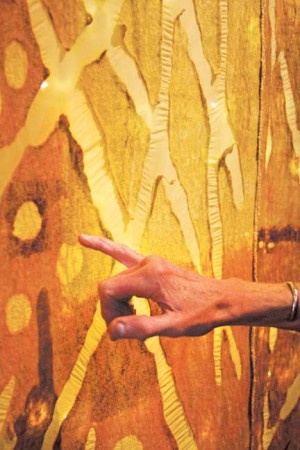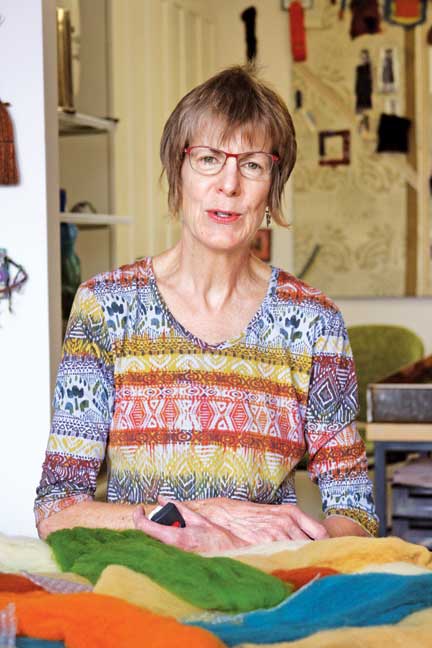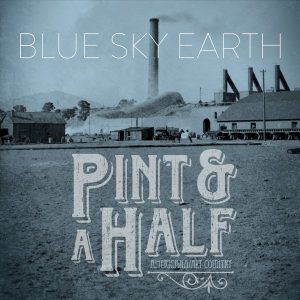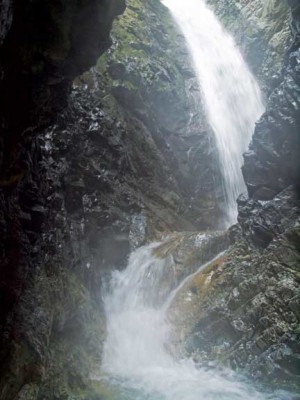by Ericka Kastner
Felting has been around for a long time. But the large-scale wall installations and glow boxes created by PJ Bergin in her Salida Felt in Hand Studio are exceptionally unusual.
It’s been seven years since PJ launched her business and website, and the majority of her work is primarily commissioned pieces for medical facilities or conference rooms. One of her first commissions was for the lobby at the Heart of the Rockies Regional Medical Center in Salida. She’s also created two large site-specific installations for Kaiser Permanente Medical Facilities in Denver.
She says people often question whether her work is fine art and not just a craft project because she isn’t turning out oil paintings. PJ does what she can to educate art collectors and consultants as to the artistic merit of her work. “I can see it when people study my work; they can really identify with it on a deeper level because of the tactile element.”

PJ says her work is similar to an oil painting in that it’s layered, but different in that she fabricates her own canvas, forming it with her hands. To fashion her textiles, PJ starts with plain white wool breeds that have structure built into their fibers. She dyes the wool in a process that takes two days for each color, eventually laying an average of 16 layers of wool, taking time to design and shape as she works. Throughout her efforts, PJ may stand on a ladder to expand her perspective and to ensure the piece is balanced.
At this point, PJ typically gives herself a few days to think about the work before felting. When she does eventually begin to apply water to the wool, the fibers resist at first. “It’s like a sheep’s wool. It doesn’t want to absorb water, so it takes a lot of time.” From here, she begins to roll, compress and shrink the textile, watching the wool change its character in an undertaking lasting 8 to 10 hours a day for four or five days. “It takes a great deal of standing, physical work and willpower to create these pieces, so a lot of people don’t want to do what I do.”
At the start of a project, PJ has an intended direction for the work, but she says there is always a certain amount of surprise and unpredictability in the end. Density and smoothness determine whether a piece is finished, but ultimately the wool compresses to 30 percent of its original size. Once the creation is dry, PJ often adds wire or paint to the tapestries.
As a child raised in upstate New York and spending summers with her grandmother in Denver’s Washington Park neighborhood, PJ says even then she needed to have her hands building, working. “For me, there wasn’t really ever any choice [other than what I’m doing now].”
[InContentAdTwo]
When PJ began her textiles journey with an education at the Fashion Institute of Technology in New York City, she envisioned herself sitting in a neat little shop in Cherry Creek, designing one-of-a-kind clothing for wealthy Denver women. Somewhere along the way, PJ got sidetracked devising large-scale textile wall installations for high end homes in the Western U.S. At one point she also spent six months in Mexico City doing much of the same kind of work, wrapping walls with fabric in the form of flat installations for other interior designers, translating their visions.

“I wanted to continue this work, but I also had my own interpretation and I was ready to make the installations three-dimensional.” This vision lead to PJ working with wool as a medium because fundamentally, she knew wool would do what she wanted it to do.
When asked what she loves most about her work, PJ says she enjoys playing with and balancing color. She also loves the impact her textiles have on the Feng Shui of interior spaces and how her art affects the viewer’s psyche. “I’m not interested in doing any political work. My art is aimed at elevating the spirit, making people relax and maybe look inward a bit. I want them to come up with their own interpretation and have a unique experience. It can be emotional or literal.”
“Art doesn’t have to be just a painting on a wall. I want to show people this, and to inspire other artists. That’s my mission in life. Seeing my work, getting it out into the world is what makes it all come full circle.”
To view PJ’s work online, visit feltinhand.com.
Ericka Kastner uses her hands to play with words and strum her ukulele in her loft in downtown Salida. View more of her writing and photography online at erickakastner.com.



